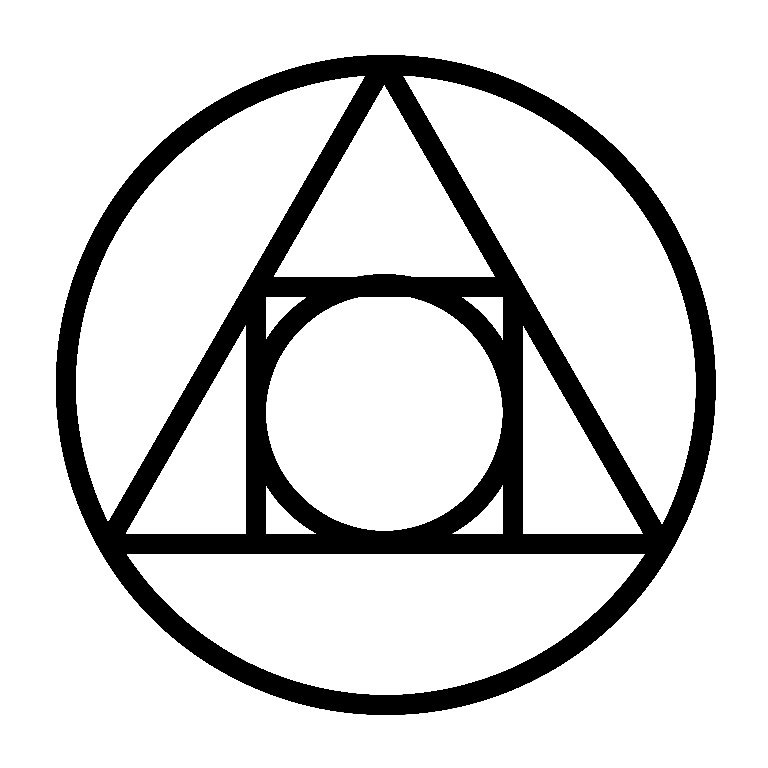The Alchemical Symbol for Fire

The Alchemical Symbol for Fire
Origins and Development
The symbol for Fire (△) — a simple upward-pointing triangle — is one of humanity’s oldest emblems of transformation. Its geometric form predates alchemy by more than a millennium, appearing in Greek and pre-Socratic cosmology as the sign of ascent, lightness, and motion.
The earliest clear conceptual reference is found in Empedocles (5th century BCE), who named Fire one of the four rhizomata or roots of all things. Aristotle later formalized the association of Fire with the qualities hot and dry, and with upward motion in On the Heavens. The triangle’s apex represented rising energy, flame, and aspiration — inverting it produced the symbol for Water, its natural opposite.
By the Hellenistic era, Fire’s triangle had entered Hermetic and astrological manuscripts as both pictogram and philosophical shorthand. In the Byzantine codices and early Latin alchemical works, such as the Liber Hermetis and Turba Philosophorum, the symbol acquired its canonical form: an equilateral triangle, representing perfect balance among elemental forces, but oriented upward to mark the dynamic principle of spirit in matter.
Meaning in Alchemical Doctrine
For the alchemist, Fire was not simply combustion — it was the universal agent of change, both material and spiritual. The motto Igne Natura Renovatur Integra (“Through Fire Nature is renewed whole”) appears throughout Renaissance manuscripts and Masonic ritual alike.
In the Paracelsian tria prima, Fire corresponds most closely with Sulfur, the active, combustible soul of matter. It is that which moves, excites, and transmutes — the essence of volatility. Alchemists often called it the “internal fire”, the secret heat latent within all created things, mirroring the Sun in miniature.
Historical attributes:
-
Qualities: Hot and dry
-
Direction: South
-
Season: Summer
-
Humor: Choleric (per Galenic medicine)
-
Planetary affinity: Mars and the Sun
-
Associated color: Red or gold
Fire was the great purifier. In both Basil Valentine’s Twelve Keys and Michael Maier’s Atalanta Fugiens, the burning furnace (athanor) symbolizes not destruction but refinement — the stripping away of dross to reveal incorruptible essence.
Fire in Texts and Imagery
Alchemical engravings frequently show Fire as a lion, dragon, or salamander — all creatures said to dwell within flame. The salamander, in particular, symbolized the spirit that endures within suffering, echoing the alchemist’s trials in the laboratory.
In Robert Fludd’s Utriusque Cosmi Historia (1617), Fire is placed at the summit of the elemental pyramid, nearest to the Empyrean sphere — the divine intellect. Below it descend Air, Water, and Earth, in that order. Fire thus becomes the gateway between visible nature and invisible spirit, the primary mover of the Great Work.
This symbolic hierarchy aligns with interpretations in Deciphering the Method, where Fire represents the energetic phase of the Stone’s gestation — the moment of ignition where potential becomes transformation. Similarly, the Book of Aquarius identifies the “fire of nature” as both physical heat and vital force.
Laboratory and Philosophical Roles
Practically, Fire served as the governing element of the furnace and all subsequent separations — calcination, sublimation, and coagulation. Symbolically, it was will — the directed human intention that sustains the Work.
Alchemists distinguished between:
-
External fire (ignis artificialis) — literal flame or heat source.
-
Internal fire (ignis noster) — the hidden warmth of life and consciousness animating the materia.
In this dual sense, Fire unified craft and contemplation. It required both the disciplined hand and the illuminated mind.
The role of Fire as transmuter and purifier forms a cornerstone in Western alchemy and Hermetic philosophy. Its connection to Sulfur and Solar power links it directly to the themes explored in the R.A.M.S. Library of Alchemy — where flame, light, and spirit converge as aspects of the same principle.
